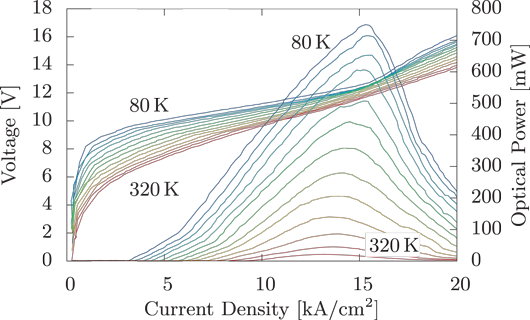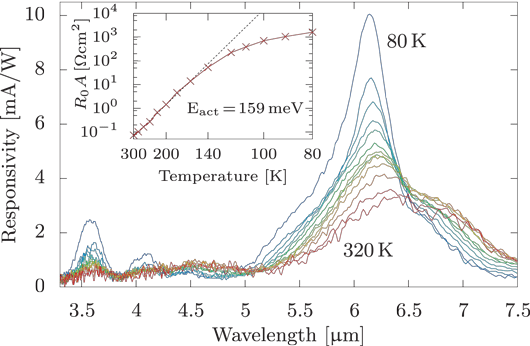- News
23 November 2012
Bifunctional quantum cascade laser/detector
Vienna University of Technology has developed a quantum cascade device that can act as both laser and detector over the same wavelength range [Benedikt Schwarz et al, Appl. Phys. Lett., vol101, p191109, 2012].
Quantum cascade (QC) structures consist of a large number of semiconductor layers that present a series of steps as electrons proceed through the device. Transitions between the energy levels of the steps can be arranged to emit coherent photons, if the laser condition of population inversion can be produced through a lower level that is very rapidly emptied.
The first QC laser (QCL) was reported in 1994. More recently, QC structures have been produced that reverse the process by detecting electromagnetic radiation.

Figure 1: Optical output power and current-voltage characteristic of the bifunctional device. Curves were measured from a 10μm x 2mm ridge laser with 100ns pulses at 5kHz. Absolute output power was measured with a calibrated DTGS pyroelectric detector.
QCLs have potential application for spectroscopy of biological and chemical sensing in gas- and liquid-phases. By combining with detector capabilities, it is hoped to develop more compact monolithic systems for mobile chemical fingerprinting. One further attraction of QC detectors (QCDs) is that they are operated at zero-bias, avoiding problems due to dark current. QCDs can also perform better than quantum well infrared photodetectors (QWIPs) at higher temperatures.
In principle, it would seem simple to combine the two functions of light emission and detection. There is a catch, however. The laser transition is usually between two excited levels, with the lower level having a fast non-electromagnetic transition to the ground state to give population inversion. By contrast, detection is achieved through excitation from the ground state. The laser transition therefore generally has a smaller energy difference than the detector. This smaller energy red-shifts the laser emission wavelength range compared with the detector capability of a given QC structure.
To overcome these problems, the Vienna University of Technology team carried out extensive simulations before producing their device experimentally. The intrinsic wavelength shift between laser and detector operation was compensated for by inserting a narrow well between the injector and active-well sections of the cascade. By tuning the narrow well, the researchers were able to red-shift the wavelength band for detection, overcoming the intrinsic blue-shift.

Figure 2: Spectral responsivity of the detector at different temperatures. Inset: resistance-area product as a function of inverse temperature. Spectra were measured from a 10μm x 0.6mm ridge with a FTIR spectrometer, normalized by atmospheric absorption spectrum. Absolute values were measured with a cw laser adjusted to 10mW. Considering the measured spot profile and the 5μm x 10μm facet, as well as the transmission of the ZnSe cryo-window, the researchers corrected the laser power for the responsivity calculation to 2.8mW.
Molecular beam epitaxy (MBE) was used to create the many-layered slightly strain-compensated indium gallium arsenide (InGaAs) well in indium aluminium arsenide (InAlAs) structure on n-type indium phosphide (n-InP) substrate. The 35-period active region was sandwiched between InGaAs cladding layers. A top cladding of InAlAs was also used. Laser devices were produced with 10μm-wide ridges. Two cavity lengths were studied: 2mm and 0.6mm.
The laser wavelength and detector sensitivity range overlapped in the range 6.4-6.8μm. The researchers believe that, operated in a distributed feedback cavity, the device structure could offer bifunctional operation in the range 6.2-7.1μm.
Laser operation for the device with a 2mm cavity had a threshold current at room temperature of 8kA/cm2. The pulsed peak output power was 45mW. The researchers comment: “The improvement of the device performance, especially the reduction of the threshold current, will be a major issue of our future work on bifunctional quantum cascade devices.”
Detector operation (0.6mm cavity) had a peak responsivity of 10mA/W at 80K and 3.6mA/W at 300K. The detector performance is comparable with that of pure QCDs. The detector is Johnson noise limited. The specific detectivity is 2.8x109 Jones at 80K and 6.9x106 Jones at 300K.
QCL QCD MBE InGaAs InAlAs n-InP substrate
The author Mike Cooke is a freelance technology journalist who has worked in the semiconductor and advanced technology sectors since 1997.


